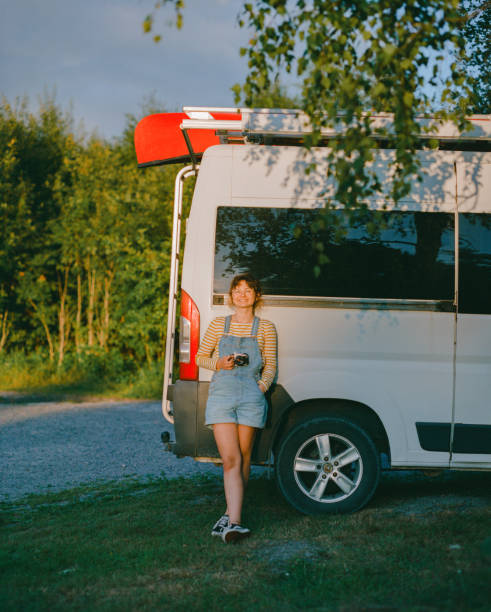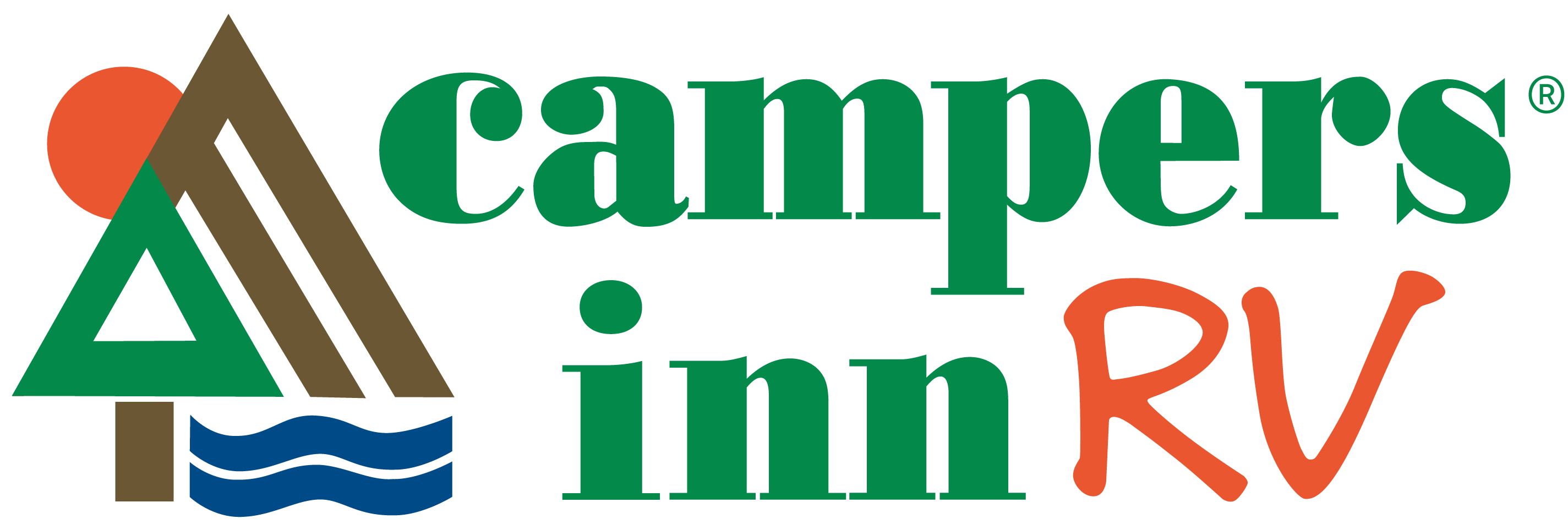
Question: “I’ve reserved a great campsite for an extended stay for my family vacation this year. Can you walk me through what I should expect when we arrive at the campsite?”
Sure. But let’s back up just a little bit…
Before leaving on your trip, be sure the camper is washed and ready to travel. Don’t be “that guy” who finds his battery is bad or his water lines stink after arriving at the campsite. There may be plenty of people willing to help out, but all these little problems cut into your time for relaxing and enjoying your camper. Preparation is key!

As described in previous blogs, every checklist should include the following:
- Check the condition of the battery(s). Make certain that the battery connections are correct and tight before plugging in the power cord.
- Inspect your propane regulator and pigtail(s) (if equipped). Fill and install DOT cylinder(s) and open the service valves all the way. ASME motorhome tanks should be filled and checked for leaks before any camping trip.
- Leave the propane service valve(s) open while performing the remaining checks. You should be able to smell any propane leak in the RV system if present. It is extremely important to address any propane leak(s) before using your camper. If you do smell a propane leak, shut off the service valve(s) and contact the RV dealership to have the system professionally leak tested and repaired.
- Plug in the power cord and verify the battery is being charged from the on-board converter. If not, check for blown fuses/breakers at the converter and at the battery location
- Flush all remaining RV antifreeze from the water lines by connecting a listed safe water hose and opening one faucet at a time, hot and cold through the coach until clear water runs from all faucets. Be sure you have extra washers for your water hose connection(s). Ensure that your holding tanks’ “dump valves” are closed.
- If using a tank-filled water heater, install the drain plug and fill the water heater tank with fresh water by opening the bypass valve(s). Skip this step if using a tankless water heater.
- Inspect the tires for cracks in the sidewall or tread. Ensure that the tires’ tread is adequate. Set the tire air pressure according to the data tag (not the maximum pressure listed on the sidewall). The tire pressure/inflation information is typically located on the data tag at the front driver side of a travel trailer or 5th wheel on or near the driver’s door opening on motorhomes.
- Perform a running light check by connecting the trailer to the tow-vehicle. Motorhomes also have headlights that need to work on high-beam and low-beam. Inspect the chassis for damaged parts, springs, shackles shocks, etc…
- Inspect the roof and sidewalls for cracks or voids in sealants. Clean the area first, then apply sealant(s) that are designed to be used both on RVs and on the surface you are re-sealing. Ask anyone at the parts department of your RV dealership for advice on proper sealants.
- If you are towing your RV to the campground, be absolutely certain that your hitch and towing equipment is in good working order and you understand how to use it. Remember: your family’s safety depends on it!
- Pack your cargo! Do not overload your camper. Refer to the data tag for loading information specifically the “Cargo Carrying Capacity” listed on the tag information. This is the Maximum Cargo weight you can add to the camper to tow it safely. Also try to balance the load, both front to back and side to side, to ensure that the axle capacities are within safe parameters.

Now let’s get to the campground…
Whether you are staying in a “drive-through” site at the campground, or you need to back the camper into the proper spot, either way, it is best to have a “spotter” guide you when setting your camper onto the campsite’s RV pad. Also, have any other passengers stand clear or stay in the tow-vehicle.
Communication is key! Before backing a trailer, both the driver and spotter should walk all the way around the back and sides of the trailer or motorhome to see where any possible obstructions may be including low tree branches or structures that may interfere with slide outs and slide toppers. The driver and spotter should have a clear understanding of the verbal and hand signals they will use with each other BEFORE guiding the rig to its preferred spot.
Avoid using words like “Whoa..” (rhymes with “Go!”), but rather use “Forward”, “Back” and so forth. “Stop” ALWAYS means “STOP”. The spotter should pay close attention to all sides and the top of the camper (including air conditioners and antennas) when it is moving. The spotter MUST maintain direct line of sight with the driver when the rig is moving!
Use leveling ramps if needed to back the trailer or motorhome onto the final 1-2 ft (or so) of distance. Any unit that is not equipped with an automatic leveling system should be parked with the tires level side-to-side before un-hitching. Leveling ramps should be standard equipment for weekend or seasonal camping trips. With a typical travel trailer, the ramps can be placed directly behind the rear tires on the “low side”. Carefully back the rig onto the ramp(s) and be ready to stop quickly when the tire gets to the top of the ramp’s surface. This is the position where you will park the camper and disconnect the hitch before leveling front to back.
Uncouple and disconnect the camper from the tow vehicle hitch equipment.

Once the camper is set in its proper place on the RV pad, you can use the front tongue jack or 5th wheel jacks to level the trailer front to back. If equipped, use the leveling system to completely level the coach. Then, use the stabilizer jacks (if equipped) to firm up the coach to the ground. Rather than extend scissor jacks all the way out, use blocks placed underneath the jacks to maintain 2/3 or less extension of the stab jacks.
Before entering the coach, make all the water and electric service connections. It tends to be easier to do this while the slide outs are retracted so you may opt to run a power cord or sewer hose (for instance) underneath a slide out.
If you have city water available, connect a proper hose (listed for potable water) tightly to the camper’s inlet and turn on the water supply to check for leaks. You do not want to have a mud puddle in front of your water connections!
If the campsite is equipped with electrical hook-ups, connect your power cord to the appropriate RV receptacle at the pedestal. Make sure the breaker is in the “on” position after plugging in the cord. Route the cord so it does not interfere with heavy foot traffic.
Check that your holding tank valves are all closed and connect the sewer hose. It is okay to open any “grey” tank valves after connecting to a campground sewer, but it is always best to leave the “black” tank valve closed until it is at least 2/3 full. The reason is that when a user flushes the toilet, water enters the tank which helps break down any solids that may accumulate. Then, the contents can be “washed” out with the water when emptying the tank later.
Before extending slide outs, look for any cargo that may have shifted and might obstruct the movement of the slide room(s). Be sure to walk around the exterior of the coach to see if there are any obstructions that may interfere with the space when they are extended. Use a spotter when moving a slide out or awning in an area where there is a tree branch or structure that is “close”. Remember “Stop” means “STOP!”
Make sure the refrigerator and other appliances are operating properly. Open seating areas, window coverings, etc… Check cabinets and storage areas for any cargo that may have shifted. Plus, make sure that your entertainment system operates as designed.
Now it’s time to relax. Get your favorite drink and kick your feet up. If anything does not operate properly while using your camper, remember why you are there in the first place. Relax! You can contact the dealership during business hours Monday thru Saturday and with most RV dealerships, on Sundays too. We've got your back!
Good luck, and happy camping!
Keith Marshall 2025 Master Certified RVTI Level 4 Technician



